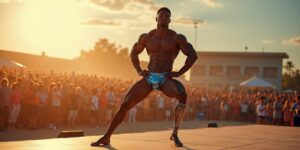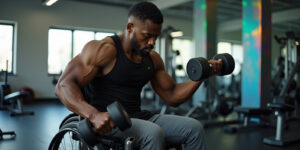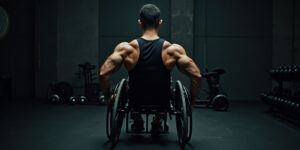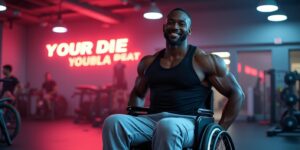Hey, champs! Whether you’re a seasoned bodybuilder or just starting your fitness journey, building strength and pushing limits isn’t about doing it the conventional way—it’s about doing it your way. If you’re a disabled bodybuilder, you already know you’re part of a resilient, elite squad. Now, let’s fine-tune your approach to both preparing for a workout and recovering like a pro.
Here’s your complete guide, packed with actionable tips to take your training to the next level.
Step 1: Prepping for Success—The Pre-Workout Plan
Your warm-up and preparation lay the groundwork for a solid workout. Here’s how to make sure you’re starting strong:
- Prioritize Nutrition Like a Scientist
Think of your body as a high-performance machine—it needs premium fuel.
- Carbs for energy: Whether you’re using a wheelchair or prosthetics, your body burns energy fast. Have a small carb-heavy snack 30–60 minutes before your session. Oatmeal, bananas, or whole-grain toast work wonders.
- Protein for strength: Incorporate lean protein like chicken, eggs, or a plant-based protein shake. Protein primes your muscles for repair, especially if you’re working on muscle imbalances.
- Hydration is king: Being dehydrated even slightly can lead to fatigue and cramps. Sip on water or electrolyte drinks throughout the day.
2. Choose the Right Pre-Workout Supplements
Not every supplement is created equal. Look for:
- Caffeine or low-caffeine options: Boosts focus and endurance, but go for a dose that doesn’t spike your heart rate.
- Beta-Alanine: Helps buffer lactic acid, delaying fatigue during intense sets.
- Nitric Oxide Boosters: Improve blood flow and oxygen delivery, which can be crucial if certain areas of your body have restricted circulation.
Pro Tip: Always check with your doctor if you’re new to supplements or have specific medical conditions.
3. Adapt Your Warm-Up
Mobility may look different for everyone, but the goal is the same: warming up muscles and prepping joints to handle heavy loads.
- Use resistance bands to activate smaller muscle groups.
- Perform dynamic stretches tailored to your range of motion. For wheelchair users, focus on shoulders, neck, and arms.
- Core activation is crucial for stability during lifts—try seated torso twists or planks if feasible.
4. Set a Game Plan
Heading into the gym without a strategy? Rookie mistake.
- Design your workout split (push, pull, legs, or a focus on adaptive-specific exercises).
- Know your accessible equipment. Machines like cable systems and seated presses are great if mobility is limited.
- Track progress—whether it’s more reps, better form, or higher weight, small wins stack up.
Step 2: Crushing the Workout—Stay Strong and Smart
- Focus on Proper Form Over Weight
Your body’s biomechanics might differ, but proper form remains key to preventing injuries and maximizing gains. Work with a trainer experienced in adaptive fitness if possible.
- Use Adaptive Equipment
From straps for gripping weights to specialized benches, adaptive tools can make all the difference. Don’t hesitate to modify traditional movements to suit your abilities. For example:
- Replace squats with seated leg presses.
- Try seated rows to target your back.
- Know When to Push and When to Pause
Listen to your body. Fatigue can hit faster due to additional energy demands from mobility aids or other factors. Rest between sets when needed and avoid overtraining.
Step 3: Recover Like a Champion
What happens post-workout is just as critical as the reps you crushed in the gym. Recovery sets the stage for growth, strength, and sustainability.
- Stretch it Out
Cool-down stretches improve flexibility, reduce soreness, and prevent stiffness. Focus on areas you worked the most, and don’t neglect the smaller stabilizer muscles.
- Refuel Within 30 Minutes
Post-workout nutrition isn’t optional—it’s essential for recovery.
- Protein is non-negotiable: Aim for 20–30 grams from a shake, chicken breast, or tofu.
- Don’t skip carbs: Pair your protein with some sweet potatoes, rice, or fruits to restore glycogen levels.
- Prioritize Sleep Like a Pro Athlete
Sleep isn’t just rest; it’s when your body gets to work repairing muscles. If sleep challenges you due to chronic pain or other conditions, consider these tips:
- Create a wind-down routine with stretches or meditation.
- Use supportive pillows to ease pressure points.
- Embrace Active Recovery
On your rest days, keep moving with low-intensity activities like swimming, yoga, or a light wheelchair roll around your neighborhood. Active recovery boosts circulation and keeps soreness at bay.
Special Considerations for Disabled Bodybuilders
- Managing Fatigue
You’re not just recovering from workouts—daily mobility can add strain. Factor in rest periods or lighter training weeks to avoid burnout.
- Overcoming Muscle Imbalances
Imbalances are common when certain muscle groups compensate for others. Add extra focus on unilateral movements, like single-arm presses or one-legged exercises.
- Pain Management
Pain doesn’t always mean gain. Incorporate therapies like massages, foam rolling, or even professional physical therapy to stay ahead of discomfort.
- Mental Strength
Bodybuilding is as much a mental game as it is physical. Celebrate every achievement, whether it’s lifting heavier or perfecting a movement. Stay motivated by connecting with other adaptive athletes or joining an online community.
Pro Tools and Gear for Disabled Bodybuilders
The right equipment can make your workout safer and more effective. Here are some must-haves:
- Adaptive grips and cuffs: Helps secure weights for those with limited grip strength.
- Resistance bands: Perfect for low-impact workouts or rehabilitation exercises.
- Seated balance trainers: Helps improve core strength and stability for wheelchair users.
- Smartphone fitness apps: Track your progress, and many have features tailored to adaptive fitness.
Final Thoughts
Disabled bodybuilders, you’re redefining what strength and determination mean every day. The path you’re carving isn’t just inspirational—it’s downright unstoppable. From pre-workout prep to post-workout recovery, every step you take is a testament to your resilience.
Remember: There’s no “one-size-fits-all” in bodybuilding, especially for adaptive athletes. Tailor these tips to your unique needs, and don’t hesitate to experiment with what works best for you.
Now go out there and crush it—rep by rep, lift by lift, you’re proving that limits are only what we choose to accept.
FAQs
- Can I build muscle as effectively as non-disabled bodybuilders?
Absolutely! Progress might look different, but consistency, proper nutrition, and tailored workouts will lead to incredible gains.
- What’s the best way to prevent injuries?
Focus on form, include a proper warm-up and cool-down, and don’t ignore pain. Modify exercises as needed.
- How often should I train?
It depends on your recovery ability and goals. Aim for 3–5 days a week, with active recovery days in between.
- What if I don’t see results quickly?
Patience is part of the process. Track small wins like better endurance, increased reps, or improved form to stay motivated.




